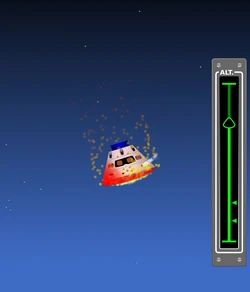
An Orion Crew Capsule during the early stages of re-entry. The white plume of its maneuvering thrusters can be seen as they fire sideways, to re-align the capsule's orientation during its descent.
Atmospheric entry (Re-entry in-game) occurs when a spacecraft (or any other object) enters the atmosphere of a planet, such as the Earth (NaviComp:HOM). Ideally, the intention is for the safe splash down landing in a body of water or liquid.
Successful entry can only be performed with the following spacecraft:
- Atmospheric Probe
- Crew Capsule
- Crew Capsule Dockable
- Draco Cargo Capsule
- Draco Crew Capsule
- Gemini Capsule
- Soyuz Capsule
- Orion Crew Capsule
The Space Shuttle cannot be reentered into an atmosphere, because of a faulty heat shield.
The planets that can be entered and splashed down on are Earth, green, gold, Kate and Emma.
During re-entry, the spacecraft is experiencing turbulence, caused by extreme aerodynamic drag. If the spacecraft's body is exposed to the airflow for too long, it will overheat and then explode.
After re-entry, the parachute will be available. The parachute must be deployed between the two arrows on the altitude indicator; otherwise, the capsule will crash.
Advanced Techniques[]
Late parachute[]
During re-entry based missions, the timer stops when you hit the water, not when you deploy your parachute. Because of this, it's significantly faster to deploy your parachute as late as possible, so that you fall more quickly for longer. Using the re-entry quick play, you can see that deploying the parachute immediately gives you a time around 2 minutes, while waiting until the last possible second can shave 20 seconds off that time.
Rocking[]
During re-entry, your capsule will only experience random rotations if you aren't already rotating. The optimal strategy is to slowly rock back and forth, using only 2 or 3 rotations on each rock. This can make re-entry easier, and save fuel if you've already used some up, for example using thrusters to rotate the capsule before entering, or using them as the last push to de-orbit.
Do a barrel roll[]
The crew capsule has enough health to survive a barrel roll, if you have enough fuel to pull it off. This is completely useless and doesn't even have a theoretical purpose, but it looks really cool. Be careful deploying the parachute while upside-down, as the swinging can make you exceed the rotation speed limit in rare cases.
Trivia[]
- In actual atmospheric entry spacecraft, the spacecraft's mass is situated so its center of gravity is very low in the spacecraft, which assists in keeping the heat shield facing down so it will protect the spacecraft. Typically, the bottoms of space capsules are curved, which also aids in keeping the capsule oriented upright during the descent of atmospheric entry.

Re-entry in real life.
- In real life, the vessel is pointing at a shallow angle, around 10 degrees on the initial re-entry. This allows the craft to slow down in thinner atmosphere, thus reducing stress on the craft.
